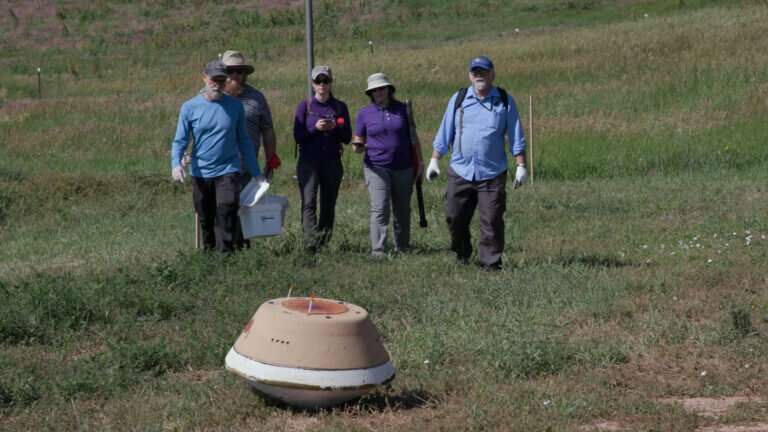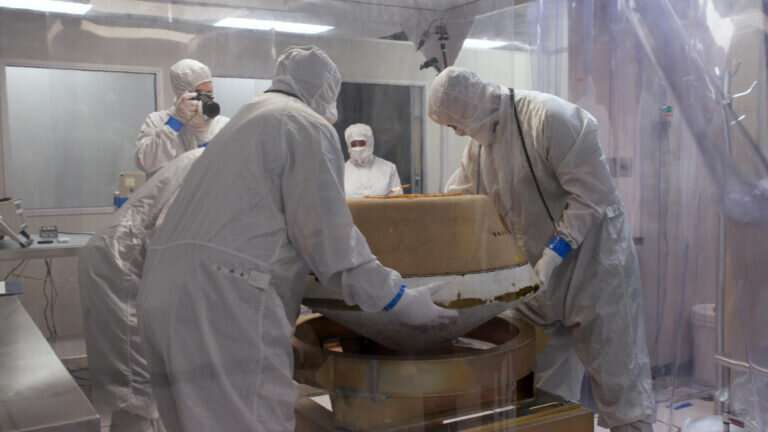This article has been reviewed according to Science X's editorial process and policies. Editors have highlighted the following attributes while ensuring the content's credibility:
fact-checked
trusted source
proofread
Practicing the game-winning asteroid sample catch

The capsule looked like something from a 1960s sci-fi flick. Resting on the ground, slightly tilted, its white heat shield flaked off in places, it looked how one would expect after speeding in from outer space and streaking across the sky like a shooting star. Despite its appearance, the mini-fridge-sized object had, in fact, never left the surface of Earth.
Instead, it was a replica of the sample capsule mounted on NASA's OSIRIS-REx spacecraft, which has been cruising through space since it departed asteroid Bennu in May 2021 with an estimated half-pound of pristine asteroid material aboard. For training purposes, engineers placed the replica capsule on a field on the Lockheed Martin campus near Littleton, Colorado, where the spacecraft was built.
OSIRIS-REx team members from NASA, Lockheed Martin, and the University of Arizona had gathered in Littleton on June 27 and 28 to rehearse recovering the capsule. The real one will land on the Department of Defense's Utah Test and Training Range on Sept. 24.
"We're literally on a playground here," said mission Principal Investigator Dante Lauretta, a professor of planetary sciences at University of Arizona in Tucson. "We have room to mess up and practice for the real thing."
For the June exercise, the recovery team members took their positions next to wooden stakes that represented the four helicopters that will fly them to the capsule landing site.
Picking up a container that dropped from the sky via parachute, bearing 4.5-billion-year-old material collected from an asteroid, is a big deal. The Bennu sample contains primitive material, which could include organic compounds that are found in all Earth life. This material may provide insight into a time when the sun and planets were born in the swirling cloud of gas and dust that became the solar system. A major goal of the OSIRIS-REx mission is to understand the evolution of organic molecules through solar system history.

Such pristine asteroid material is precious to researchers because it has been shielded from Earth's environment, unlike meteorites that fall to the ground and are collected on the surface. So the team in Colorado practiced taking samples from the environment around the capsule to create a library of everything it could get exposed to—soil, air, organic matter and so on.
Documenting the environmental conditions around the capsule will be critical for science, Lauretta said, "That way, if we find something that looks fundamental to the origin of life, we'll have no doubt, and should be able to rule it out as a contaminant because of that documented history."
Before any team members could approach the capsule to collect environmental evidence, Vicki Thiem, a safety engineer with Lockheed Martin, rehearsed taking its temperature, which she'll do on Sept. 24 to ensure the capsule has cooled down from its fiery descent through the atmosphere.
Next, the safety team practiced inspecting the area around the capsule for potential hazards, such as gases that might be emanating from it. Once the capsule was secured, Lauretta and his team inspected the terrain, planting little red flags into the ground to demarcate a "keep-out zone" where they needed to collect samples.
Once the capsule was ready for transport, two people lifted the 100-pound (45-kilogram) replica into a metal crate and wrapped it in multiple sheets of Teflon and a tarp. Next, they wrapped the crate in a harness that was secured to a cable that, in real life, will be attached to a helicopter and flown to a clean room set up in a hangar where the capsule will be opened and the sample canister extracted. The day after the sample lands on Earth, the canister and capsule will be flown to NASA's Johnson Space Center in Houston where the sample will be cared for, stored, and distributed to global scientists.
The OSIRIS-REx team has two rehearsals left, each with increasingly realistic conditions, at the Utah military training range where the capsule will land this fall.
Provided by NASA





















